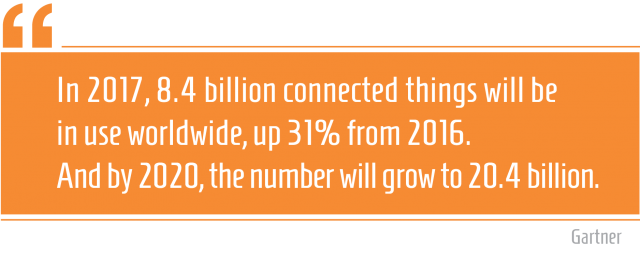In the early 2000s, a car that could diagnose itself and send real-time data to the manufacturer or to emergency services seemed far-fetched. So was a home device that could play music or order virtually anything online based on your voice commands. Also on that list of “crazy” ideas: an alarm clock that could notify the coffee maker to start brewing your favorite coffee when you wake up or a smart lock that automatically unlocks when it detects the owner.
But these ideas are now a reality, thanks to the Internet of Things (IoT) – commonly known as Machine-to-Machine (M2M) communication.
Q: What is the IoT or M2M communication?
A: The basic concept is the ability to connect different “Things” to the internet (or with each other) to facilitate the collection and transfer of data between devices.
A “Thing” can be everything from:
- A human with internal organ monitoring implants
- An animal with a biochip transponder or a tracking collar
- A vehicle with built-in sensors
- A component of a huge machine with embedded actuators
- Or a physical device like a cell phone, watch, refrigerator, door bell or almost anything that has the ability to connect to a network with an on/off switch
Q: How will the rise of connected machines impact manufacturers?
A: It’s already having a substantial impact on the industry – changing what companies make, as well as how they store and analyze data transmitted by their products.
In fact, it’s become a driving force to change the design of products themselves to accommodate sensors, chips, processors, data storage units, embedded software and connectivity – and ultimately produce even smarter products for customers.
Of course, that further adds to the number of devices communicating across networks, thus requiring:
- Scalable cloud storage to store all of that real-time data
- New applications and cloud services to securely transfer and analyze data for quality insights, so manufacturers can create better products and marketing strategies in the future
That’s why businesses are now investing a large amount of their budgets in cloud technologies and applications.
Q: What’s exciting about these connected machines?
A: The IoT is steadily becoming an integral part of our lives by:
- Transforming our homes with intelligent appliances and connected devices
- Improving healthcare with smart sensors and systems that allow doctors to monitor a patient’s health condition remotely at any time
- Increasing productivity and efficiency of businesses by improving the predictive and preventive maintenance of mechanical equipment, using embedded monitoring devices to track performance and notify the appropriate people when maintenance is due or when something seems incorrect
- Allowing companies to automate their inventory management by using smart devices that track every item in their inventory and transfer useful data to workers
Q: Final words … any challenges and predictions for the IoT?
The word “connection” in Information Technology is always accompanied by some challenges. And with billions of devices connected together, security will always be a big issue because the entire network can open up by simply hacking a small device in the network. (E.g., Just imagine someone hacking your smart-clock and gaining access to your bank accounts through it.)
The other important challenge for businesses is the privacy of user data and the way they plan to manage, store and analyze the huge amounts of data generated by these devices.
There are a lot of predictions on how the IoT will change the future. Here are a couple important ones:
- Gartner forecasts that 8.4 billion connected things will be in use worldwide in 2017, up 31% from 2016, and will reach 20.4 billion by 2020.
- IDC predicts that worldwide spending on IoT will grow at a 17% compound annual growth rate (CAGR) to reach nearly $1.3 trillion in 2019.
So the rise of connected machines is definitely the next “big” thing that will change how we live and work. Are you ready?



